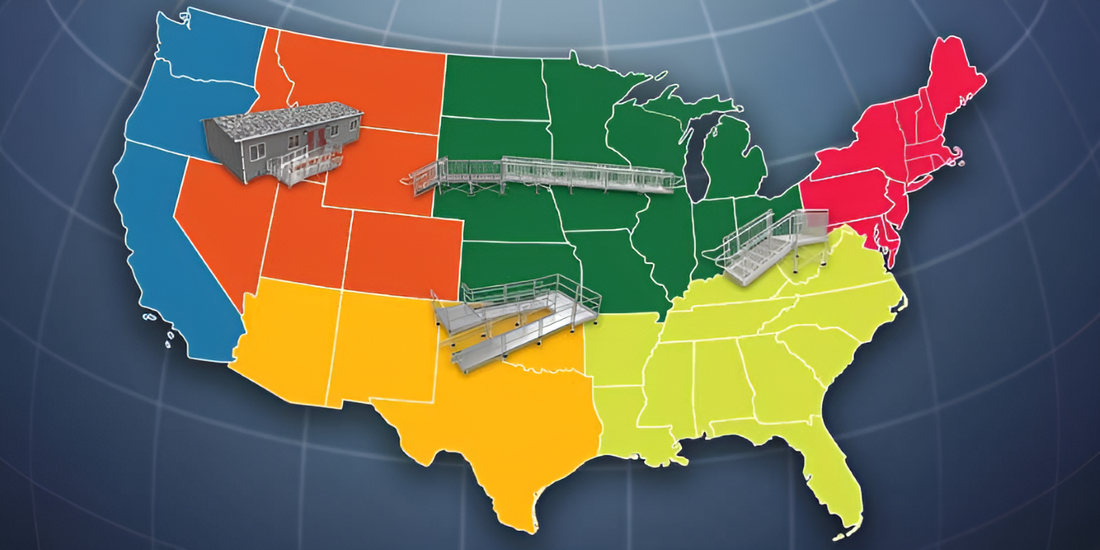Weather is a peculiar thing.
One area of the country has a streamlined system for clearing snow off streets, other states have no need to own a snow plow. Whether you have tornado drills or hurricane warnings, your accessibility options will be impacted by the weather, no matter where your projects are located.
Below we explain how outdoor ramp and stair systems are affected by the local climate, and how you can address it.
.jpg)
Pacific Region
OR, WA, CA

Climate: The Pacific Ocean dominates weather patterns in these states, which creates a constant drizzle for residents throughout most of the year. While the summer sun kisses Southern California beaches, these areas still don’t escape the wet weather during the rest of the year.
Effect: The damp air and frequent rain cause hazardous conditions for ramp and stair systems. Water buildup prevents shoes and wheels from sticking to the surface, making slips and falls much more frequent.

Rocky Mountain Region
MT, ID, NV, WY, UT, CO

Climate: While the air in these states is typically dry, differences in elevation greatly affect the weather. The higher the elevation, the more extreme the weather. Cities experience a variety of weather from intense heat that penetrates through the thin layers of atmosphere to several feet of snow each winter.
Effect: The severe sun exposure combined with snow that doesn’t melt for days, easily warps accessibility solutions made with poor materials.

Midwest Region
ND, SD, NE, KS, MN, IA, MO, IL, WI, MI, IN, OH

Climate: The middle of the country experiences all four seasons every single year. This means heavy snowfall, muddy surfaces, high temperatures, and a ground covered in leaves. Oftentimes the weather is unpredictable, so there’s really no way for residents and businesses to prepare too far in advance.
Effect: Not only can improper materials, like wood, get warped from all the elements, but they are very difficult to clean. Leaves and mud stick to the wood, creating a slippery slope for any building entrance.

Southwest Region
AZ, NM, TX, OK

Climate: The Southwest is the hottest and driest region of the U.S. and is often plagued by droughts and extreme heat.
Effect: Sun exposure greatly discolors wood ramps, which is more of a maintenance issue than a safety one. Stains tend to fade easily in the sun, which makes a bad impression for a business when their accessibility solutions look old. This can create a negative impression of safety issues more than anything.

Southeast Region
AR, LA, MS, TN, AL, GA, FL, SC, VA, WV

Climate: The Southeast is also very warm, with temperatures ranging from the upper 80s to lower 90s. Since these states are so close to the Gulf of Mexico and the Atlantic Ocean, humidity and thunderstorms are very common.
Effect: The constant moisture of this region can cause some ramps and stair systems to rot. This compromises the integrity of the structure, making it unstable for anyone to walk or ride on.

Northeast Region
PA, NY, VT, ME, NH, MA, RI, CT, NJ, DE, MD, DC

Climate: Urban and rural areas are spread throughout the Northeast, but both experience all sorts of extreme weather. From ice storms to heat waves, it can be exhausting trying to keep up.
Effect: The most hazardous form of extreme weather for accessibility solutions is the freezing ice that comes with colder storms. Once that ice freezes on a ramp or stair system, people are likely to tumble and obtain serious injuries.
Every one of these weather effects can be solved with one simple solution: an all-aluminum ramp system.
The PATHWAY® HD Code Compliant Modular Access System is made out of corrosion-resistant aluminum that offers a durable, low-maintenance means of access that will last a lifetime. Our system remains sturdy through extreme weather, and the raised-rib tread (the Gecko Grip®) allows for superb slip-resistance as people walk in and out of a building.
Take a look at our durable accessibility solutions here or reach out to us today!

